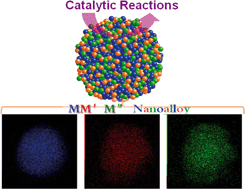Nanoalloy catalysts: structural and catalytic properties
Abstract
Noble metals alloyed with certain transition metals in the form of a nanoalloy exhibit enhanced catalytic or electrocatalytic activities for various reactions, especially when oxygen activation is involved in the reactions. Recent studies have gained important insights into how the interatomic distances and structures of the nanoalloy catalysts operate synergistically in activating oxygen and maneuvering surface oxygenated species. This article highlights some of these insights into nanoalloy catalysts in which Pt is alloyed with a second and/or third transition metal (M/M′ = Co, Fe, V, Ni, Ir, etc.), for catalytic oxidation of carbon monoxide in the gas phase and electrocatalytic oxygen reduction reaction in fuel cell reaction conditions. One important emphasis is placed on understanding of atomic-scale chemical/structural ordering and coordination in correlation with the catalytic or electrocatalytic properties based on findings from ex and in situ synchrotron X-ray techniques such as high energy X-ray diffraction coupled to atomic pair distribution function and X-ray absorption fine structure spectroscopic analysis. The understanding of the details of active sites of the nanoalloys has significant implications for the design of low-cost, active, and durable catalysts for sustainable energy production and conversion reactions.


 Please wait while we load your content...
Please wait while we load your content...